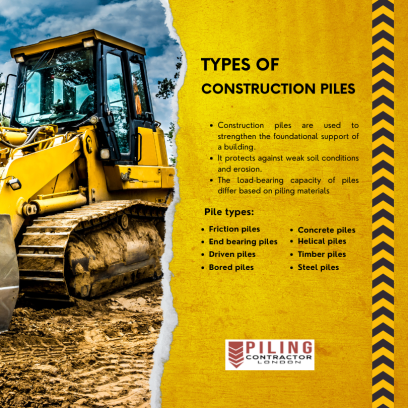
Different Types of Construction Piles and Their Usage
Construction piles are made of reinforced concrete or steel to build a strong foundation for a concrete structure. Different types of piles, such as friction piles, end-bearing piles, driven piles, steel piles, etc., are used for various purposes.
If you are willing to understand different types of construction piles and their usage, read to the end. In the following discussion, we’ll discuss various types of piles and their usage in construction work.
What is construction piling?
Piling is the process of drilling holes or boring long, sturdy piles to provide solid foundational support to a building. It helps distribute the building's weight to a broader area, supporting the structure more efficiently.
An expert piling contractor first surveys the ground and condition of the building. Appropriate piles are used based on the soil type and condition of the structure.
What are the different types of piles?
Depending on the condition of the construction site, a piling contractor will discuss with engineers and architects how to determine the appropriate type of piles to be used. Engineers and contractors also consider installing construction piles' possible structural or environmental impact.
Figure 1: Different types of construction piles
Friction piles are one of piling contractors' most commonly used piling techniques. They transform the load of the building onto the surface of the piles.
When the existing layer of soil is weak, or a strong layer can not be found easily, friction piles are used. The underground friction piles support structures above the ground through friction or adhesive force.
Friction piles are used in constructing residential or commercial buildings, construction of large factories, etc.
End-bearing piles are deep underground piles that transfer load from topsoil to a much stronger layer of soil or rock deep into the ground.
It is used when the upper layer of soil is weaker and strong foundational support is required for the building. Similar to constructing any construction piles, engineers analyse the soil quality and the scale of construction before choosing to use end-bearing piles.
It is more robust in bearing loads than friction piles. It also supports buildings by providing a solid foundation.
Driven piles are the most cost-effective construction piles, and they are commonly used to support buildings, walls, towers, etc.
An impact or vibration hammer drives it deep into the ground. Your piling contractor may use the vibration hammer to drive piles in the ground. Due to its soundlessness, neither noise pollution occurs, nor surrounding buildings are impacted. Different types of driven piles, such as steel, precast concrete, timber, etc., are used to support buildings where soil quality is loose.
Bored piles are made by drilling cylindrical holes in the ground, and workers pour liquid concrete into them. Compared to other piles, bored piles are much more secure as they are cast into the same position.
Each bored pile can be customised according to the borehole or the structure's requirements. Two common types of bored piles are Rotary bored piling and Continues Flight Auger (CFA) piling.
Concrete piles are used in various construction projects. They are ubiquitous in offshore projects, such as floating airports and oil rigs.
Concrete piles are more suitable for the above-mentioned projects as they efficiently distribute structural loads and withstand wave forces.
Helical or screwed piles are installed using a torque motor attachment assisting in the careful installation of the pile.
Helical piles are used to provide foundational support to permanent or temporary structures. The drilling process is carefully monitored to ensure the screwed piles reach the desired strata in the underground.
After the completion of the screwed pile's installation, a steel flange plate or rebar can be used to connect it to the concrete.
Your piling contractor may suggest using timber if your building is in soil that continuously changes its structure when mixed with water.
Timber piles are usually made of saal, teak, deodar, khair, etc. Khair timber is generally considered long-lasting and used in coastal areas.
A drop hammer drives the timber piles deep into the ground.
Steel piles are generally used for their high load-bearing capacity. A steel pipe can bear approximately 100 tons per pile.
Building structures that are heavy and large requires steel piles.
Steel piles can withstand roughness but are vulnerable to corrosion. There are two types of steel piles: H-piles and pipe piles.
Conclusion
Each type of construction pile is used based on the scale of the construction, soil quality, and structure load. Your piling contractor should have the knowledge to guide you better.
If you are looking for an expert piling contractor, contact us today. Piling Contractor London has a highly responsive, efficient, and experienced team that can offer you the best piling services across London.